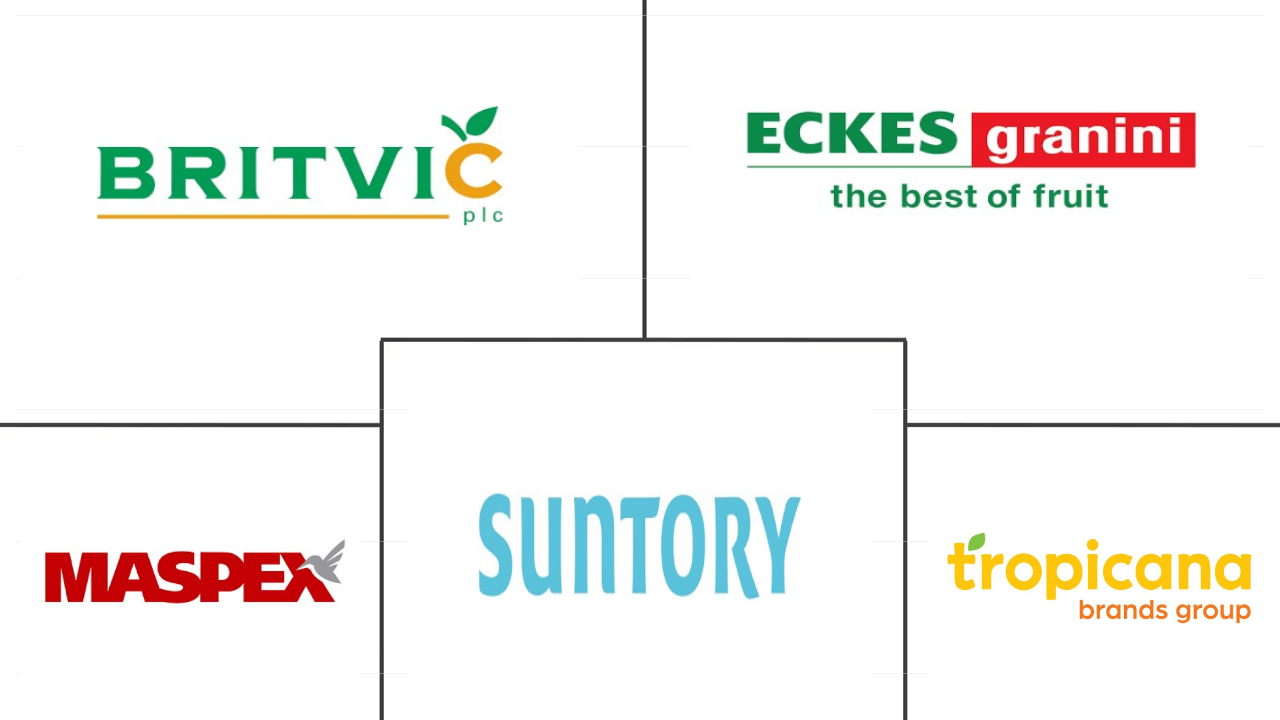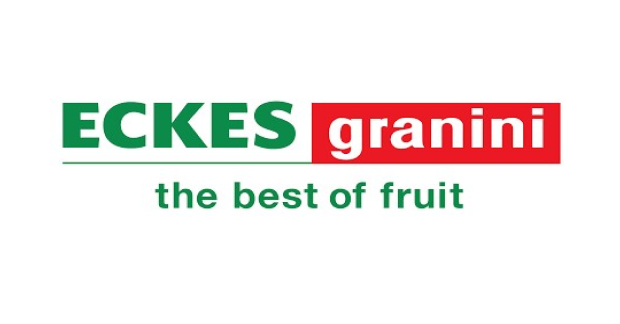Market Size of europe juices Industry
|
|
Study Period | 2018 - 2030 |
|
|
Market Size (2024) | USD 37.55 Billion |
|
|
Market Size (2030) | USD 47.44 Billion |
|
|
Largest Share by Soft Drink Type | 100% Juice |
|
|
CAGR (2024 - 2030) | 3.97 % |
|
|
Largest Share by Country | Germany |
Major Players |
||

|
||
|
*Disclaimer: Major Players sorted in no particular order |
Europe Juices Market Analysis
The Europe Juices Market size is estimated at 37.55 billion USD in 2024, and is expected to reach 47.44 billion USD by 2030, growing at a CAGR of 3.97% during the forecast period (2024-2030).
37.55 Billion
Market Size in 2024 (USD)
47.44 Billion
Market Size in 2030 (USD)
2.96 %
CAGR (2018-2023)
3.97 %
CAGR (2024-2030)
Largest Segment by Soft Drink Type
57.57 %
value share, 100% Juice, 2023
Growing consumer demand for beverages with nutritional benefits, fewer calories, and less sugar that are made with natural ingredients is driving growth of 100% Juices segment.
Fastest-growing segment by Soft Drink Type
4.62 %
Projected CAGR, Juice concentrates, 2024-2030
With their widespread use as an ingredient in soft drinks, jams, jellies, and baby foods the demand for juice concentrates is expected to grow in the forecast period.
Leading Market Player
2.58 %
market share, Eckes-Granini Group GmbH, 2022

Product quality, unique positioning, sustainable innovations, and a strong focus on consumer needs and expectations are making Eckes Aktiengesellschaft occupy the Company.
Largest Segment by Country
16.59 %
value share, Germany, 2023

Consumers' preference for less-sweet flavors, sugar content, naturalness, and shifting consumer focus to pricing are some of the factors driving the German market.
Fastest-growing segment by Country
6.46 %
Projected CAGR, Turkey, 2024-2030
Juice consumption in Turkey is anticipated to increase with a rise in health and wellness awareness leading to increasing acceptance towards healthier and functional products.
Reduced sugar intake by consumers in the region is driving the growth of the 100% juice segment
- In 2023, the 100% juice segment dominated the market, capturing the largest market share. In 2022, approximately 50% to 55% of adults actively sought to reduce their sugar intake, highlighting widespread concerns over this ingredient. In the United Kingdom, 53% of females and 45% of males who aimed to cut down on sugar preferred food and drinks with reduced or no sugar content. This trend toward healthier choices extends to night-time drinking occasions, with a growing emphasis on low-sugar and non-sweet flavors.
- As the demand for juices surged in the region, imports followed suit. In 2022, the Netherlands, France, Germany, the United Kingdom, and Belgium emerged as the top importers, collectively accounting for 80% of European imports. Orange juice leads the pack as the most-produced juice in Europe, accounting for 24% of the market. Other significant juice varieties include juice mixtures (21%), apple juice (15%), and grape juice (8%). Fruit purées and concentrated fruit purées are used in the manufacturing of specific juices (such as strawberry, peach, and apricot). They are obtained by suitable processes; for instance, by sieving, grinding, and milling the edible part of the whole/ peeled fruit, without removing juice.
- Juice drinks, with juice content up to 24%, are gaining traction and are projected to witness a CAGR of 4.15% during 2024-2030. Companies are increasingly tailoring their juice drink offerings to cater to the preferences of health-conscious consumers. In the United Kingdom, over half of the 16 to 24 age group consumed juice drinks daily in 2021. Orange juice reigns supreme as the most favored juice in the United Kingdom, especially among younger adults. In 2022, the per capita fruit juice consumption in the country stood at approximately 16.1 liters.
Climatic influences with a rise in hectic lifestyles drive the consumption of different juices in the region
- In Europe, the fruit juices market is witnessing a surge in demand for chilled organic variants, driven by a growing consumer preference for natural products. Consumers are becoming increasingly informed and able to distinguish the quality of products, influenced by factors like climate, premiumization, and evolving lifestyles. The increase in fast-paced lifestyles presents an opportunity for "on-the-go" juice consumption. Health-conscious and ethically-minded consumers are gravitating toward fruit juices in the 100% juice format, which accounted for a 62.56% value share in 2023.
- Among European countries, Germany led in terms of juice consumption by value in 2023. The country's beverage culture, coupled with a rising number of juice processing units, is fueling the demand for juices. However, in terms of consumption volume, the Netherlands took the lead and is expected to maintain the lead throughout the study period. Taste preferences, followed closely by health benefits, drive juice consumption in the Netherlands. For instance, in 2022, a significant majority (80%) of Dutch consumers cited taste as the primary reason for consuming fruit juices, while an additional 33% highlighted health benefits.
- Turkey stands out as the fastest-growing market, and it is projected to record a CAGR of 6.46% in value from 2023 to 2030. This growth is partly attributed to a regulation that bans the sale of nectars in schools. This policy shift has prompted many nectar producers to pivot toward fruit juice production, ensuring their continued presence in school establishments.
Europe Juices Industry Segmentation
100% Juice, Juice Drinks (up to 24% Juice), Juice concentrates, Nectars (25-99% Juice) are covered as segments by Soft Drink Type. Aseptic packages, Disposable Cups, Glass Bottles, Metal Can, PET Bottles are covered as segments by Packaging Type. Off-trade, On-trade are covered as segments by Distribution Channel. Belgium, France, Germany, Italy, Netherlands, Russia, Spain, Turkey, United Kingdom are covered as segments by Country.
- In 2023, the 100% juice segment dominated the market, capturing the largest market share. In 2022, approximately 50% to 55% of adults actively sought to reduce their sugar intake, highlighting widespread concerns over this ingredient. In the United Kingdom, 53% of females and 45% of males who aimed to cut down on sugar preferred food and drinks with reduced or no sugar content. This trend toward healthier choices extends to night-time drinking occasions, with a growing emphasis on low-sugar and non-sweet flavors.
- As the demand for juices surged in the region, imports followed suit. In 2022, the Netherlands, France, Germany, the United Kingdom, and Belgium emerged as the top importers, collectively accounting for 80% of European imports. Orange juice leads the pack as the most-produced juice in Europe, accounting for 24% of the market. Other significant juice varieties include juice mixtures (21%), apple juice (15%), and grape juice (8%). Fruit purées and concentrated fruit purées are used in the manufacturing of specific juices (such as strawberry, peach, and apricot). They are obtained by suitable processes; for instance, by sieving, grinding, and milling the edible part of the whole/ peeled fruit, without removing juice.
- Juice drinks, with juice content up to 24%, are gaining traction and are projected to witness a CAGR of 4.15% during 2024-2030. Companies are increasingly tailoring their juice drink offerings to cater to the preferences of health-conscious consumers. In the United Kingdom, over half of the 16 to 24 age group consumed juice drinks daily in 2021. Orange juice reigns supreme as the most favored juice in the United Kingdom, especially among younger adults. In 2022, the per capita fruit juice consumption in the country stood at approximately 16.1 liters.
| Soft Drink Type | |
| 100% Juice | |
| Juice Drinks (up to 24% Juice) | |
| Juice concentrates | |
| Nectars (25-99% Juice) |
| Packaging Type | |
| Aseptic packages | |
| Disposable Cups | |
| Glass Bottles | |
| Metal Can | |
| PET Bottles |
| Distribution Channel | ||||||
| ||||||
| On-trade |
| Country | |
| Belgium | |
| France | |
| Germany | |
| Italy | |
| Netherlands | |
| Russia | |
| Spain | |
| Turkey | |
| United Kingdom | |
| Rest of Europe |
Europe Juices Market Size Summary
The Europe Juices Market is experiencing a notable expansion, driven by a shift in consumer preferences towards healthier and more natural beverage options. The market is characterized by a strong demand for 100% juice products, which have captured a significant portion of the market share. This trend is underscored by a growing awareness among consumers about the health implications of sugar intake, leading to a preference for low-sugar and non-sweet flavor options. The market is also witnessing an increase in the popularity of juice drinks with lower juice content, as companies tailor their offerings to meet the needs of health-conscious consumers. The demand for chilled organic fruit juices is on the rise, reflecting a broader consumer inclination towards premium and natural products. This shift is further supported by the fast-paced lifestyles of consumers, which create opportunities for convenient "on-the-go" juice consumption.
In terms of market dynamics, Germany leads in juice consumption by value, while the Netherlands holds the top position in consumption volume, driven by taste preferences and health benefits. The United Kingdom sees a high consumption of juice drinks, particularly among younger adults, with orange juice being the most favored variety. Turkey is emerging as the fastest-growing market, influenced by regulatory changes that encourage a shift from nectar to fruit juice production. The market is fragmented, with major players like Britvic PLC, Eckes-Granini Group GmbH, Maspex Wadowice Grupa, Suntory Holdings Limited, and Tropicana Brands Group holding a modest share. Innovations and new product launches, such as unique flavor combinations and zero-added sugar options, are contributing to the evolving landscape of the European juices market.
Europe Juices Market Size - Table of Contents
-
1. MARKET SEGMENTATION (includes market size in Value in USD and Volume, Forecasts up to 2030 and analysis of growth prospects)
-
1.1 Soft Drink Type
-
1.1.1 100% Juice
-
1.1.2 Juice Drinks (up to 24% Juice)
-
1.1.3 Juice concentrates
-
1.1.4 Nectars (25-99% Juice)
-
-
1.2 Packaging Type
-
1.2.1 Aseptic packages
-
1.2.2 Disposable Cups
-
1.2.3 Glass Bottles
-
1.2.4 Metal Can
-
1.2.5 PET Bottles
-
-
1.3 Distribution Channel
-
1.3.1 Off-trade
-
1.3.1.1 Convenience Stores
-
1.3.1.2 Online Retail
-
1.3.1.3 Supermarket/Hypermarket
-
1.3.1.4 Others
-
-
1.3.2 On-trade
-
-
1.4 Country
-
1.4.1 Belgium
-
1.4.2 France
-
1.4.3 Germany
-
1.4.4 Italy
-
1.4.5 Netherlands
-
1.4.6 Russia
-
1.4.7 Spain
-
1.4.8 Turkey
-
1.4.9 United Kingdom
-
1.4.10 Rest of Europe
-
-
Europe Juices Market Size FAQs
How big is the Europe Juices Market?
The Europe Juices Market size is expected to reach USD 37.55 billion in 2024 and grow at a CAGR of 3.97% to reach USD 47.44 billion by 2030.
What is the current Europe Juices Market size?
In 2024, the Europe Juices Market size is expected to reach USD 37.55 billion.

